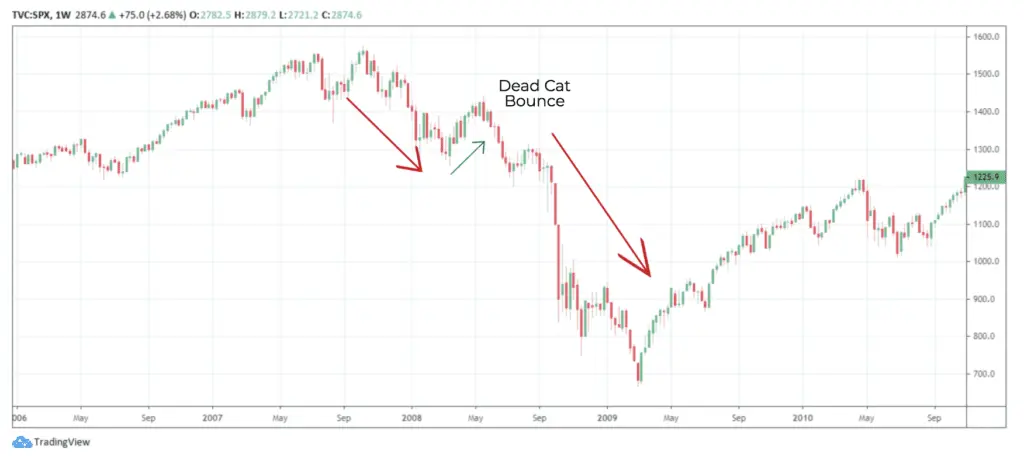The term “Dead Cat Bounce” is one of the most intriguing concepts in Forex Trading. It represents a temporary Market Recovery that follows a sharp decline in asset prices. This bounce often misleads traders into believing the trend has reversed. However, this recovery is short-lived, and prices usually continue their downward trajectory. Understanding this phenomenon is critical for making informed decisions in volatile markets. By mastering this concept, traders can distinguish between false recoveries and genuine upward trends.
What Is a Dead Cat Bounce?

A Dead Cat Bounce refers to a brief price rebound that occurs after a steep decline. This phenomenon gets its name from the idea that even a dead cat bounces if it falls from a great height. The bounce often lures traders into thinking the worst is over. However, the asset usually resumes its downward movement soon after. For example, a currency pair may drop significantly due to weak economic data. It might then experience a brief upward correction before continuing its fall.
In Forex Trading, this pattern is especially common due to the market’s high liquidity and constant volatility. Recognizing it can help traders avoid costly mistakes and better manage risks.
Why Is It Important in Forex Trading?
Forex traders must be adept at identifying a Bounce to succeed. First, it helps them avoid being trapped in false recoveries. For instance, a trader might see a short-term Market Recovery and enter a buy position. If this recovery is a Dead Cat Bounce, the price will soon resume its decline, causing significant losses.
Second, understanding this concept supports effective risk management. By identifying the bounce early, traders can set appropriate stop-loss orders. These tools minimize losses if the price reverses unexpectedly. Lastly, recognizing this pattern helps traders capitalize on short-selling opportunities. When a bounce loses momentum, traders can profit by betting on the continued downward trend.
Identifying a Dead Cat Bounce: Key Strategies
Technical Analysis
Technical Analysis is an essential tool for spotting a Dead Cat Bounce. It involves studying price charts, patterns, and indicators to predict market movements. For example, moving averages can reveal whether the bounce is part of a longer downtrend. If prices remain below key moving averages, the recovery is likely temporary.
Momentum indicators like the Relative Strength Index (RSI) or the Stochastic Oscillator can also be helpful. These tools indicate whether an asset is overbought or oversold. It often occurs when an asset briefly moves away from oversold conditions. However, it fails to gain enough momentum to trigger a full Market Recovery.
Volume Analysis
Volume Analysis plays a critical role in distinguishing between genuine recoveries and a Dead Cat Bounce. A true recovery usually sees a surge in trading volume. This increase indicates that many participants believe in the asset’s upward potential. In contrast, It often occurs on low trading volumes. This lack of activity shows weak conviction among traders.
For instance, imagine a currency pair that drops sharply due to a central bank’s policy announcement. The pair may bounce back slightly, but with low volume, this recovery is unlikely to last. Savvy traders would recognize this as a Dead Cat Bounce and plan their next move accordingly.
Factors Behind a Dead Cat Bounce
Economic News and Events
Forex markets are highly sensitive to economic news and geopolitical events. Traders must monitor these factors closely to identify a Dead Cat Bounce. For example, a temporary recovery might occur after the release of positive economic data. However, if the broader economic outlook remains negative, the bounce will likely be short-lived.
Consider the case of a weak jobs report causing a steep drop in a currency’s value. A subsequent announcement about stimulus measures might trigger a brief recovery. Without further positive news, this recovery could turn into a Dead Cat Bounce.
Market Sentiment
Market sentiment can also drive a Dead Cat Bounce. Traders’ emotions often influence short-term price movements. For instance, panic selling may lead to a sharp drop, followed by a small bounce as buyers look for bargains. However, if the fundamental issues causing the decline remain unresolved, the downward trend will resume.
Social media sentiment and news headlines often amplify this effect. Traders who rely solely on these sources may mistake a Dead Cat Bounce for a full recovery. Combining sentiment analysis with Technical Analysis and Volume Analysis helps avoid such pitfalls.
Tips for Navigating a Dead Cat Bounce
Stay Patient and Observant
Patience is essential when dealing with it. Avoid rushing into trades based on minor recoveries. For example, wait for additional confirmation signals, such as higher volumes or sustained price increases. This approach reduces the risk of making hasty, loss-inducing decisions.
Implement Risk Management Strategies
Effective risk management is crucial in volatile markets. Always use stop-loss orders to limit potential losses. For example, if you suspect a Dead Cat Bounce, set your stop-loss slightly above the bounce level. This ensures you exit the trade before the downward trend resumes.
Additionally, manage your leverage wisely. Over-leveraging can magnify losses if the bounce turns out to be temporary. Use smaller position sizes to minimize risks.
Continuously Learn and Adapt
Forex Trading requires continuous learning and adaptation. Study historical price movements and analyze past Dead Cat Bounce patterns. For example, review charts of major currency pairs during times of economic turbulence. Identifying recurring patterns helps you refine your trading strategies.
Stay updated on global economic developments and news. This information provides context for price movements and helps you differentiate between genuine recoveries and false bounces.
Case Study: Spotting a Dead Cat Bounce in Action
Let’s consider the EUR/USD currency pair during the 2008 financial crisis. The pair experienced a sharp decline due to widespread economic uncertainty. A temporary recovery followed after the European Central Bank announced interest rate cuts. However, trading volumes remained low, and technical indicators signaled weak momentum. Savvy traders identified this recovery as a Dead Cat Bounce and prepared for further declines. Their analysis paid off as the pair resumed its downward trend shortly after.
Conclusion
The Dead Cat Bounce is a vital concept for savvy Forex traders. Understanding this phenomenon helps distinguish between false recoveries and genuine market trends. By leveraging tools like Technical Analysis and Volume Analysis, traders can navigate volatile markets with confidence. Staying informed about economic events and managing risks effectively further enhances trading success.
In Forex Trading, every decision counts. Mastering the art of spotting it can be the difference between success and failure. Equip yourself with the knowledge and strategies shared in this guide. Doing so will help you stay ahead in the ever-changing world of Forex markets.
Click here to read our latest article Slippage in Forex Exposed
This post is originally published on EDGE-FOREX.



